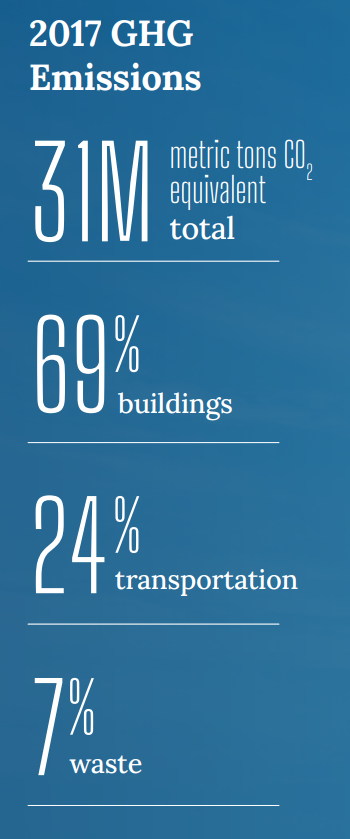Electrify Chicago
An independent tool for viewing City of Chicago building data
According to the
2022 Chicago Climate Action Plan,
69% of Chicago's emissions come from buildings, making
building emissions our biggest challenge and our biggest opportunity as a city
to tackle climate change. At Electrify Chicago, we showcase building performance using
publicly available data supplemented by community-submitted photographs and building
owners.
Start by looking at Chicago's buildings with the highest greenhouse gas intensity i.e. emissions per square foot. Large, efficient, buildings can perform much better than very inefficient small buildings on this metric.
New Article
📰 $30 Million In Missed Fines
The City Of Chicago failed to collect $30 million in potential fines from the building benchmarking ordinance, reducing transparency and accountability.
Legislative update! 🎉
As of late January 2024, legislation is being introduced to require new use more efficient forms of water and space heating, via the Clean And Affordable Buildings Ordinance (CABO), which will reduce the number of highly polluting and inefficient buildings that end up on this site.
If you're in Chicago,
write to your alderman to support the CABO!
Chicago Buildings by Greenhouse Gas Intensity
Note: Data includes large Chicago buildings with data from 2022, unless explicitly stated otherwise.
Note: This data only includes buildings whose emissions are reported
under the
Chicago Energy Benchmarking Ordinance. According to the City “As of 2016,
this list includes all commercial, institutional, and residential buildings larger than
50,000 square feet.” This dataset is also then filtered to only buildings with
reported emissions > 1,000 metric tons CO2 equivalent.
The latest year of data is from 2022, but we update the site regularly when new data is available, and some buildings may have failed to report that year, and only have older data available.
| Property Name / address | Primary Property Type |
Greenhouse Gas Intensity (kg CO2 eq./sqft) |
Total Greenhouse Emissions (metric tons CO2 eq.) |
|---|---|---|---|
|
Walsh, John A -CPS
🕰️
(CPS)
2031 S Peoria St
| K-12 School | 7.2 kg/sqft | 525 tons |
|
Lloyd Elementary -CPS
(CPS)
2103 N Lamon Ave
| K-12 School | 7.2 kg/sqft
Highest 35%
| 1,083 tons
Highest 42%
|
|
Miles Davis Elementary -CPS
🕰️
(CPS)
6740 S Paulina St
| K-12 School | 7.2 kg/sqft | 748 tons |
|
Hefferan Elementary -CPS
🕰️
(CPS)
4409 W Wilcox St
| K-12 School | 7.2 kg/sqft | 439 tons |
|
NMH Worcester House
244 E Pearson St
| Multifamily Housing | 7.2 kg/sqft
Highest 35%
| 1,049 tons
Highest 44%
|
|
8 S. Michigan Ave
8 S Michigan Ave
| Office | 7.2 kg/sqft
Highest 35%
| 1,309 tons
Highest 36%
|
|
Long Life Apts
(CHA)
344 W 28th Pl
| Multifamily Housing | 7.2 kg/sqft
Highest 35%
| 694 tons
Lowest 40%
|
|
Harry J. Schneider Apartments
(CHA)
1750 W Peterson Ave
| Multifamily Housing | 7.2 kg/sqft
Highest 35%
| 806 tons
Lowest 46%
|
|
Lowden Homes
📷
(CHA)
200 W 95th St
| Multifamily Housing | 7.2 kg/sqft
Highest 35%
| 822 tons
Lowest 47%
|
|
7219 N SHERIDAN RD
7219 N SHERIDAN RD
| Multifamily Housing | 7.2 kg/sqft
Highest 35%
| 383 tons
Lowest 15%
|
|
Victory Centre of Galewood
2370 N Newcastle Ave
| Senior Living Community | 7.2 kg/sqft
Highest 35%
| 566 tons
Lowest 31%
|
|
Jordan Comm -CPS
(CPS)
7414 N Wolcott Ave
| K-12 School | 7.2 kg/sqft
Highest 35%
| 479 tons
Lowest 24%
|
|
The Tides at Lakeshore East
360 E South Water St
| Multifamily Housing | 7.2 kg/sqft
Highest 35%
| 3,501 tons
Highest 11%
|
|
765 W Adams St
765 W Adams St
| Multifamily Housing | 7.2 kg/sqft
Highest 35%
| 2,543 tons
Highest 17%
|
|
1350-60 N LSD
1350 N Lake Shore Dr
| Multifamily Housing | 7.2 kg/sqft
Highest 35%
| 5,217 tons
Highest 6%
|
Data Source:
Chicago Energy Benchmarking Data
